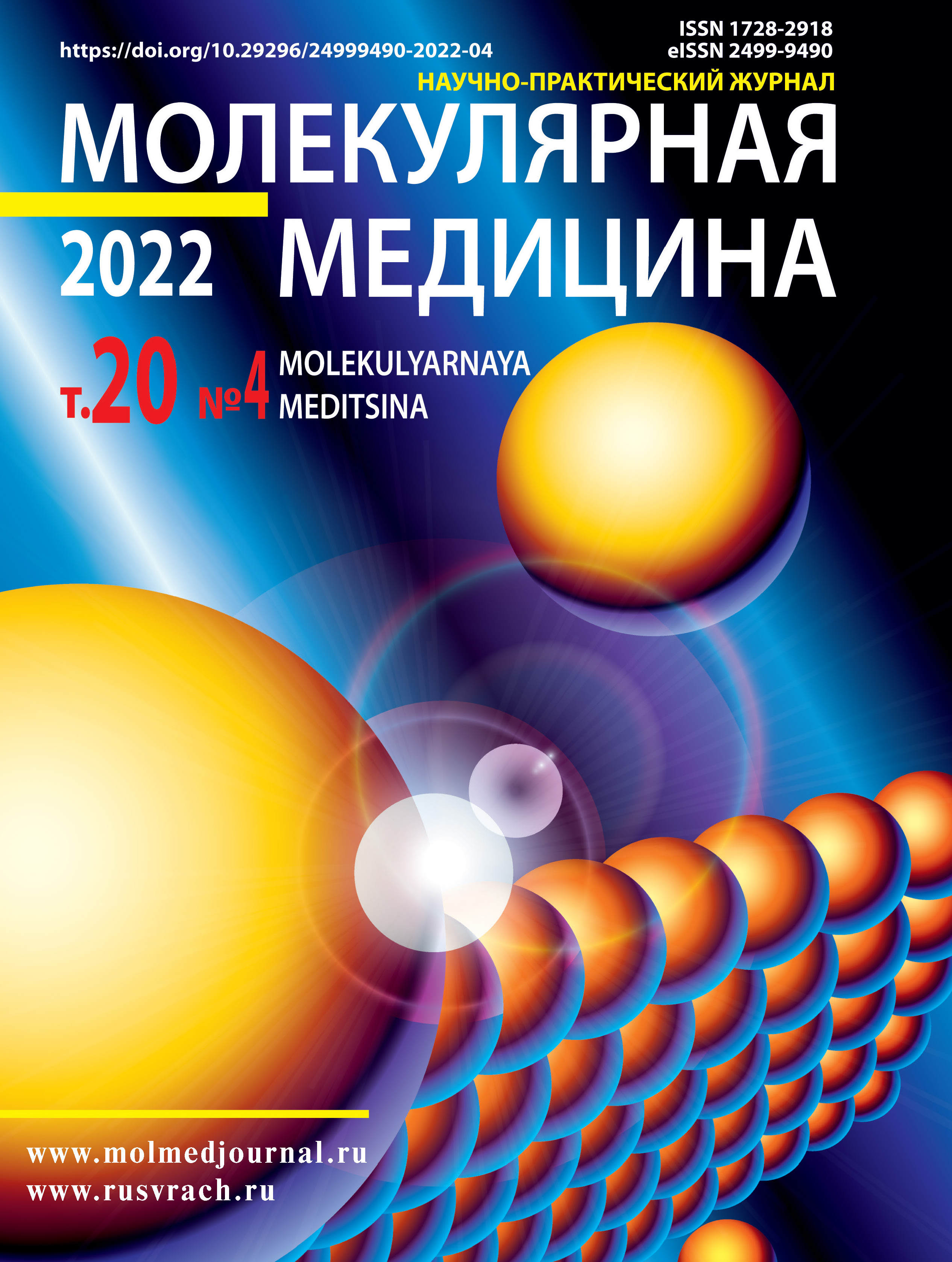Индукция апоптоза клеток рака предстательной железы экстрактом Бадяги речной
- Авторы: Николаев А.А.1, Гудинская Н.И.1, Ушакова М.В.1
-
Учреждения:
- ФГБОУ ВО «Астраханский государственный медицинский университет» Минздрава РФ
- Выпуск: Том 20, № 4 (2022)
- Страницы: 50-55
- Раздел: Статьи
- URL: https://journals.eco-vector.com/1728-2918/article/view/113786
- DOI: https://doi.org/10.29296/24999490-2022-04-08
- ID: 113786
Цитировать
Полный текст
Аннотация
Введение. Рак предстательной железы (РПЖ) на сегодняшний день является самым часто диагностируемым злокачественным новообразованием органов мочевой системы. Патогенез и молекулярные механизмы РПЖ остаются понятыми неполностью. Имеются сообщения о наличии в экстрактах нескольких видов морских и пресноводных губок биоактивных метаболитов, снижающих пролиферативную активность раковых клеток, в частности, клеток РПЖ. Целью исследования явилась оценка влияния экстракта бадяги речной (ЭБР) на жизнеспособность и апоптоз клеток РПЖ LNCAP клона ФСК (ЕСАСС 89110211) и связанный с этим механизм. Материал и методы. В работе использованы ЭБР (Ephydatia fluviatilis), клетки LNCAP клона ФСК (ЕСАСС 89110211). Анализ клеточной пролиферации проводили стандартным МТТтестом, анализ апоптоза - методом проточной цитометрии с использованием проточного цитофлуориметра Attune® NxT. Набор для обнаружения апоптоза ANNEXIN V-FITC APOPTOSIS DETECTION KIT I (BD PharmingemTM, США) использован для дальнейшего подтверждения апоптоза, чтобы определить влияние ЭБР на сигнальный путь, участвующий в этом исследовании. Проапоптотические и антиапоптотические белки в клетках LNCAP оценивали методом вестерн-блотт анализа. Результаты и обсуждение. Предварительное исследование эффекта ЭБР на пролиферацию клеток LNCAP показало, что ЭБР проявил максимальный эффект торможения роста на клетки LNCAP, начиная со 2-х суток инкубации. Дальнейший эксперимент преследовал цель выяснения зависимости ингибирующего эффекта от концентрации ЭБР в среде культивирования. Показана сильная взаимосвязь доза-ответ ЭБР и жизнеспособности клеток LNCAP. Однако показано, что ЭБР вызывал небольшое достоверное увеличение жизнеспособности клеток между 0 мкг/мл (контроль) и 6,25 мкг/мл. Такую реакцию можно объяснить известным эффектом гормезиса. При оценке профиля безопасности ЭБР показан индекс селективности 7,24. Отмечено, что именно апоптоз способствовал снижению жизнеспособности клеток РПЖ линии LNCAP после воздействия ЭБР. Существует прямая зависимость уровня апоптоза от концентрации ЭБР в культуральной жидкости. Вестерн-блоттинг клеток LNCAP, обработанных ЭБР различных концентраций (0, 50, 100 и 200 мг/мл) для оценки экспрессии белков Bcl-2, Bax показал, что уровень Bax растет, а Bcl-2 - падает. Заключение. ЭБР оказывает ингибирующее влияние на рост и жизнеспособность клеток РПЖ, вызывая их апоптоз. Обработка ЭБР также увеличивала соотношение экспрессии Bax/Bcl2, что указывает на участие митохондриально-опосредованного внутреннего апоптотического пути.
Ключевые слова
Полный текст
Об авторах
Александр Аркадьевич Николаев
ФГБОУ ВО «Астраханский государственный медицинский университет» Минздрава РФ
Email: chimnik@mail.ru
зав. кафедрой химии, доктор медицинских наук, профессор
Россия,Наталья Игоревна Гудинская
ФГБОУ ВО «Астраханский государственный медицинский университет» Минздрава РФ
Email: gudnat@yandex.ru
доцент кафедры химии, кандидат медицинских наук
Россия,Мария Владимировна Ушакова
ФГБОУ ВО «Астраханский государственный медицинский университет» Минздрава РФ
Автор, ответственный за переписку.
Email: ms.ehrich@mail.ru
доцент кафедры химии, кандидат биологических наук
Россия,Список литературы
- Винник Ю.Ю., Андрейчиков А.В., Климов Н.Ю. Современное представление о диагностике рака простаты. Урология, 2017; 2: 110-52.
- Ottinger S., Kloppel A., Rausch V., Liu L., Kallifatidis G., Gross W., Gebhard M.M., Brummer F., Herr I. Targeting of pancreatic and prostate cancer stem cell characteristics by Crambe crambe marine sponge extract. Int. J. Cancer. 2012; 130 (7): 1671-81. https://doi.org/10.1002/ijc.26168.
- Николаев А.А., Выборнов С.В. Торможение роста клеток культуры рака простаты LNCAP аналогами полиаминов, Современные проблемы науки и образования. 2016; 6: 1-8.
- Niks M., Otto M. Towards an optimized MTT assay. J. Immunol Meth 1990; 130 (1): 149-51 https://doi.org/10.1016/0022-1759(90)90309-j.
- Shi J.M., Huang H.J., Qiu S.X., Feng S.X., Li X.E. Griffipavixanthone from Garcinia oblongifolia champ induces cell apoptosis in human non-small-cell lung cancer H520 cells in vitro. Molecules. 2014; 19 (2): 1422-31. https://doi.org/10.3390/molecules19021422
- Pillai-Kastoori L., Schutz-Geschwender A.R., Harford J.A. A systematic approach to quantitative Western blot analysis. Anal Biochem. 2020; 593: 113608. https://doi.org/10.1016/j.ab.2020.113608.
- Jodynis-Liebert J., Kujawska M. Biphasic Dose-Response Induced by Phytochemicals: Experimental Evidence. J. Clin. Med. 2020; 9 (3): 2-28. https://doi.org/10.3390/jcm9030718.
- Razumov A., Zav'yalov E.L., Troitskii S.Yu., Romashchenko A.V., Petrovskii D.V., Kuper K.E., Moshkin M.P. Selective Cytotoxicity of Manganese Nanoparticles against Human Glioblastoma Cells. Bulletin of Experimental Biology and Medicine. 2017; 163 (3): 561-5. https://doi.org/10.1007/s10517-017-3849-0
Дополнительные файлы








